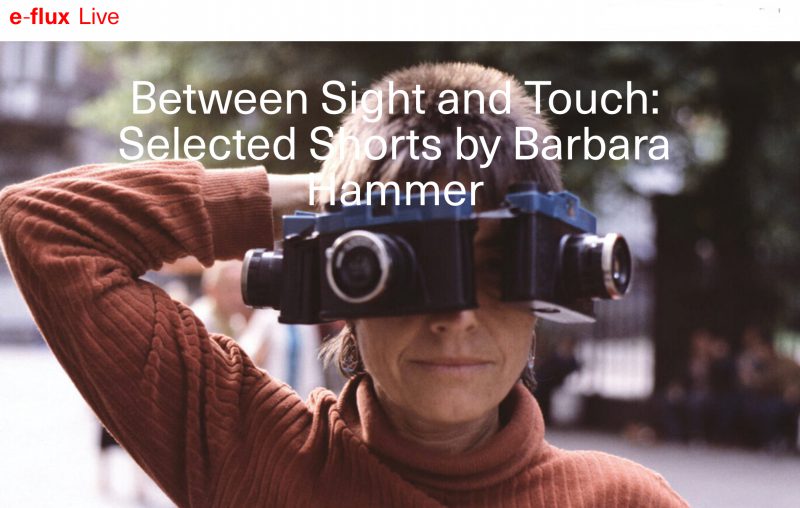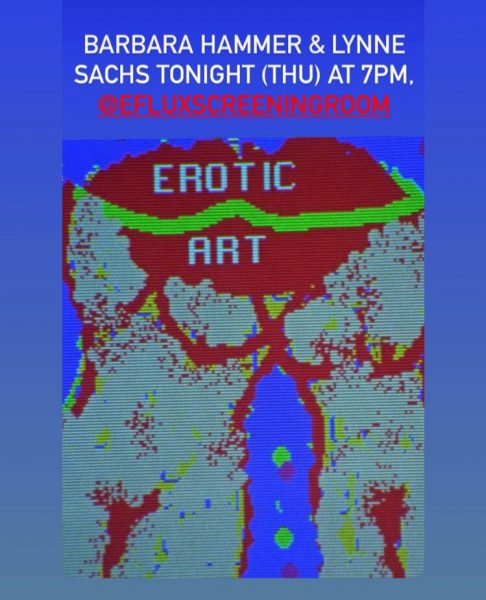
Between Sight and Touch: Selected Shorts by Barbara Hammer
e-flux Screening Room
September 19, 2022
Screening on September 22, 2022
https://www.e-flux.com/live/491616/between-sight-and-touch-selected-shorts-nbsp-by-barbara-hammer/
Introduction by Lynne Sachs
“Welcome to ‘Between Sight and Touch: Selected Shorts by Barbara Hammer’
Which is Part of EFlux Screening Room’s
Revisiting Feminist Moving-Image Art, a monthly series of screenings aimed at revisiting the origins, contexts, developments, and impact of feminist video art and experimental cinema around the world from the 1960s through the present.
It’s really an honor for me to have the chance to introduce this exciting and thought provoking selection of films by artist and dear friend Barbara Hammer.
Tonight you’ll be watching.
“Psychosynthesis”, “Women I Love”, “Sync Touch”, “No No Nooky T.V.”, “Save Sex”, and “Lesbian Whale”, accompanied by a screening of “A Month of Single Frames”
Barbara Hammer and I met in 1987 in San Francisco, a mecca for alternative, underground, experimental filmmaking. She taught me the fine, solitary craft of optical printing during a weekend workshop, thus beginning a friendship that eventually followed us across the country to New York City.
Tonight you will see her 1975 “Psychosynthesis” and her 1981 “Sync Touch” both of which will give you a sense of her masterful ability to use this extremely technical analog machine which was absolutely essential to her practice as a filmmaker who wanted to both celebrate and deconstruct – a word of the day – the culture she saw swirling around her. In “Psychosynthesis”, Barbara goes completely auto-biographical, but in oh so psychodelic way, using her body and her archive of family photos to investigate who she was and who she wanted to be. You will see her unbelievably skillful use of mattes and superimpositions here. Pre computers, this kind of image manipulation took incredible skill! Made around the same time…yes Barbara was extremely prolific, her film “Women I Love” is an openly Lesbian, openly compassionate embrace of the women in her life she holds dear. How extraordinarily brave Barbara was in the mid 1970s!
“Sync Touch”, a favorite of mine for a long time, is an exhilarating celebration of the haptic – skin to skin – in all its manifestations and a precise, ingenious investigation of feminist theory – which Barbara was clearly exploring in profound ways at the time.
Barbara first decided to call herself a moving image artist at a time when the separation between the practice of making films and the practice of making video were very, very different. More than a painter choosing oil over acrylic, a moving image artist who sided with celluloid was forced to decide how she wanted to embrace or reject a long legacy of mostly male produced media that were circulating on screens or on tv. For the most part, Barbara opted for the film side of things, but in 1987 her 12min “No Nooky TV” arrived in the scene. I dare say, the videomaking would never be the same again. This brazen, text based send up of all things “broadcast” took the body language of experimental film coming out of the 60s and 70s and transformed into a TV-minded send up of advertising, news, and mainstream graphic design – transposing the culturally tame words of the media mainstream with words like Boob, Cunt, Do It. Literal becomes Cliteral and away we go. Plus Barbara has figured out how to make and disseminate all of the wildest 1980s character-generator signage to make her feminist discourse look like something you might have seen lit up in Times Square. In her 1993 “Save Sex”, we see Barbara’s AIDS activism in full force. This Hammer-esque public service announcement type of piece that celebrates SAFE SEX while while also advocating for “saving” sex at the same time.
You will see Barbara’s face and body in most of the films curator Lukas Brasiskis is presenting tonight. Barbara always had an uncanny ability to understand herself from the inside out and from the outside in. Her films were visceral and personal. In both subtle and overt way, they were also intentionally political calling attention to the sexual inequities she witnessed everywhere.
Now I will tell you a bit about “A Month of Single Frames”, the film I made with and for Barbara.
Some background. Between 2015 to 2018, Barbara agreed to be part of the making of my short, experimental documentary Carolee, Barbara and Gunvor (2018) a three-part film that includes Carolee Schneemann and Gunvor Nelson. All three were renowned artists and beloved friends, just a generation older than I, who had embraced the moving image throughout their lives. I shot this film with Barbara near her home and studio in the West Village.
In 2018, Barbara asked me to come to her home to discuss something she needed to say in person. I immediately faced a complicated set of emotions. This was around the time she gave the talk “The Art of Dying or (Palliative Art Making in the Age of Anxiety)” at the Whitney Museum. I knew that this tête-à-tête would involve some kind of good-bye, but I had no idea that she had decided to share a part of her personal archive, and thus a part of her being on this earth, with me. Filmmaking, in the tradition that Barbara and I have espoused for most of our lives as experimental makers, involves a deeply focused solitary period of introspection. A complementary aspect of our practice, however, calls for playful, engaged exchanges with all of the people in the film — both in front and behind the camera. Fundamental to Barbara’s sense of herself as an artist was her commitment to deep and lasting intellectual engagement with her fellow artists in the field, particularly other women who were also trying to find an aesthetic language that could speak about the issues that meant so much to us. By asking me to work with her, alongside her but not “for” her, Barbara, a feminist filmmaker, was actually creating an entirely new vision of the artist’s legacy.
While writing the text for my own film, the words I placed on the screen came to me in a dream. By the time I finished my film, Barbara had died. I quickly realized that this kind of oneiric encounter could become a posthumous continuation of the dialogue I had started with Barbara.
I hope you enjoy this program, a part of a magnificent series of films and videos made by women over the years. If you are interested in reading more about my work with Barbara, you will find an essay I wrote in Camera Obscura: a journal on Feminism, Culture, and Media published last year.
I also hope that you will join me for EFlux’s presentation of my work on Oct. 27, 2022 when I will be able to join you in conversation here in Brooklyn.

Between Sight and Touch: Selected Shorts by Barbara Hammer
With a video introduction and special screening by Lynne Sachs
Admission starts at $5
Date
September 22, 2022, 7pm
172
Classon Avenue
Brooklyn, NY 11205
USA
A
lesbian/feminist aesthetic proposing the connection between touch and sight to
be the basis for a “new cinema.”
—Barbara Hammer
Join us at e-flux Screening Room on Thursday, September 22 at 7pm for Between Sight and Touch, a screening of selected works by Barbara Hammer, featuring Psychosynthesis, Women I Love, Sync Touch, No No Nooky T.V., Save Sex, and Lesbian Whale, accompanied by a screening of A Month of Single Frames by experimental documentary filmmaker and poet Lynne Sachs, who will also be introducing the evening via video.
Barbara Hammer (1939-2019), a pioneer of queer experimental filmmaking in the US, devoted most of her five-decade artistic career to the deconstruction of normative understandings of gender and sexuality. She was attempting to build a new cinema via material explorations of onscreen representations of the female body and analysis of the functioning of the film medium itself. This program features Hammer’s lesser-known short films and video works in which the artist questions the strict boundaries between the representation of gender and sexuality and the exploration of one’s body—between sight and touch.
Between Sight and Touch is part of Revisiting Feminist Moving-Image Art, a monthly series of screenings at e-flux Screening Room aimed at revisiting the origins, contexts, developments, and impact of feminist video art and experimental cinema around the world from the 1960s through the present.

Films
Barbara
Hammer, Psychosynthesis, 1975, 6 minutes
“The sub-personalities of me, as baby, athlete, witch, and artist are
synthesized in this film of superimpositions, intensities, and color layers
coming together through the powers of film.” (Barbara Hammer)
Barbara
Hammer, Women I Love, 1976, 23 minutes
A series of cameo portraits of the filmmaker’s friends and lovers intercut with
a playful celebration of fruits and vegetables in nature. Culminating footage
evokes a tantric painting of sexuality sustained.
Barbara
Hammer, Sync Touch, 1981, 10 minutes
“…The film explores the tactile child nature within the adult woman
filmmaker, the connection between sexuality and filmmaking, and the scientific
analysis of the sense of touch.” (Barbara Hammer)
Barbara
Hammer, No No Nooky T.V., 1987, 12 minutes
Using a 16mm Bolex and Amiga computer, Hammer creates a witty and stunning film
about how women view their sexuality versus the way male images of women and
sex are perceived. The impact of technology on sexuality, emotion, and the
sensual self is explored through computer language juxtaposed with the everyday
colloquial language of sex.
Barbara
Hammer, Save Sex, 1993, 1 minutes
A minute-long, partly animated color video that is a humorous plea for good
sex, safely prophylactic though it may be.
Barbara
Hammer, Lesbian Whale, 2015, 6 minutes
A video animation of Hammer’s early notebook drawings set to a soundtrack of
commentary by the artist’s friends and peers.
Lynne
Sachs, A Month of Single Frames, 2019, 14 minutes
In 1998, lesbian experimental filmmaker Barbara Hammer took part in a one-month
residency at a Cape Cod dune shack without running water or electricity, where
she shot film, recorded sound, and kept a journal. In 2018 she gave all of this
material to Lynne Sachs and invited her to make a film with it.
Accessibility
–Two flights of stairs lead up to the building’s front entrance at 172 Classon Avenue.
–For elevator access, please RSVP to program@e-flux.com. The building has a freight elevator which leads into the e-flux office space. Entrance to the elevator is nearest to 180 Classon Ave (a garage door). We have a ramp for the steps within the space.
–e-flux has an ADA-compliant bathroom. There are no steps between the Screening Room and this bathroom.
For more information, contact program@e-flux.com.
Category
Film, Sexuality & Eroticism, Feminism
Subject
Experimental Film, Video Art, Queer Art & Theory
Barbara Hammer was born in 1939 in Hollywood, California. She lived and worked in New York until her death in 2019. With a career spanning fifty years, Barbara Hammer is recognized as a pioneer of queer cinema. Working primarily in film and video, Hammer created a groundbreaking body of experimental work that illuminates lesbian histories, lives, and representations. Hammer has stated: “My work makes these invisible bodies and histories visible. As a lesbian artist, I found little existing representation, so I put lesbian life on this blank screen, leaving a cultural record for future generations.”
